Some species of frogs do eat small rodents such as mice. These tend to be larger species that are able to eat small rodents whole.
How do frogs eat?
We all know the cartoon image of a frog darting its tongue out to grab a fly and pull it back into its mouth. A frog’s tongue is used like an arm to grab what it wants to eat. In order to achieve this, most frogs have tongues three times the length of their bodies.
In order to grab their prey, frogs have incredibly sticky saliva that helps glue the animal to their tongue as it retracts into their mouth.
| Frog Species | Prey Items | Additional Information/Explanation |
|---|---|---|
| Leopard Frog | Insects, spiders, small vertebrates | Leopard frogs primarily feed on invertebrates but may consume small vertebrates like mice |
| African Bullfrog | Insects, worms, small mammals | African bullfrogs have been known to consume small mammals including mice |
| Green Frog | Insects, small invertebrates, fish | Green frogs primarily feed on insects and small invertebrates, but they may occasionally consume small fish |
| American Bullfrog | Insects, small fish, crustaceans | American bullfrogs have a diverse diet that includes insects, small fish, and crustaceans |
Once it has retracted its tongue, the frog needs to swallow the prey. In order to do this, they close their eyes and press down with them.
As frogs don’t have teeth to chew, they swallow prey whole. The prey will then drown or suffocate in their stomach, a shocking end for any creature.
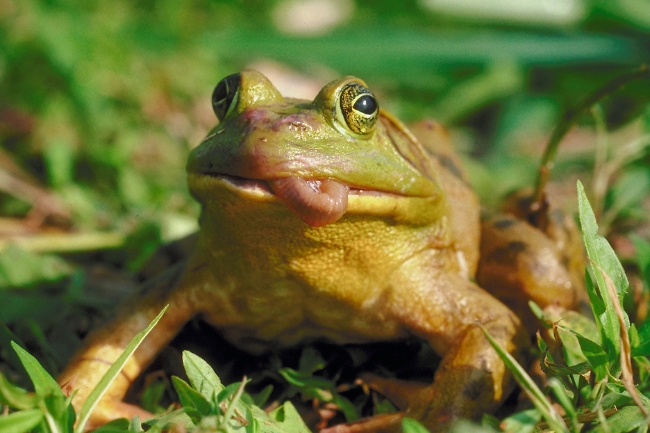
Do frogs eat mice?
There are around 7,000 species of frogs across the world. Though mostly associated with wetlands such as ponds, lakes and rivers, many spend some, or all of their life cycles away from water, in forests, grasslands and or even arid areas.
The vast majority of frogs are carnivores, meaning they eat meat. What they eat depends on where they live and what species they naturally come across. Most frogs aren’t particularly fussy, and will eat a wide variety of species.
Frogs don’t have teeth designed for chewing, though they do have maxillary and vomerine teeth that help to keep prey in place. As they do not chew, they swallow their prey whole. Therefore, frogs can’t handle prey that is too much larger than themselves or can defend itself too vigorously.
| Frog Species | Frequency of Mouse Consumption | Additional Information/Explanation |
|---|---|---|
| Leopard Frog | Occasionally | Leopard frogs may consume mice opportunistically, but it is not a primary part of their diet |
| American Bullfrog | Occasionally | American bullfrogs may consume mice opportunistically, but they primarily feed on other prey |
| Green Frog | Rarely | Green frogs rarely consume mice and generally focus on smaller prey |
| Tree Frog | Rarely | Tree frogs rarely consume mice and primarily feed on smaller insects |
Only a small number of frogs have the size and opportunity to eat small rodents, such as mice. Many aquatic species that spend all their time in the water, don’t come into regular contact with mice. However, there are still some species that do, and will eat them.
Also read: Frogs in a Pond: What Do They Eat?
A List of Mice-eating Species
| Species | Average Length (inches) | Additional Information/Explanation |
|---|---|---|
| Leopard Frog | 2-4 inches | Leopard frogs are smaller in size compared to most mice species |
| American Bullfrog | 3.6-6 inches | American bullfrogs are larger in size compared to most mice species |
| Green Frog | 2.4-4 inches | Green frogs are similar in size to some smaller mouse species |
| House Mouse | 3-4 inches | House mice are similar in size to some smaller frog species |
Chilean helmeted bullfrog
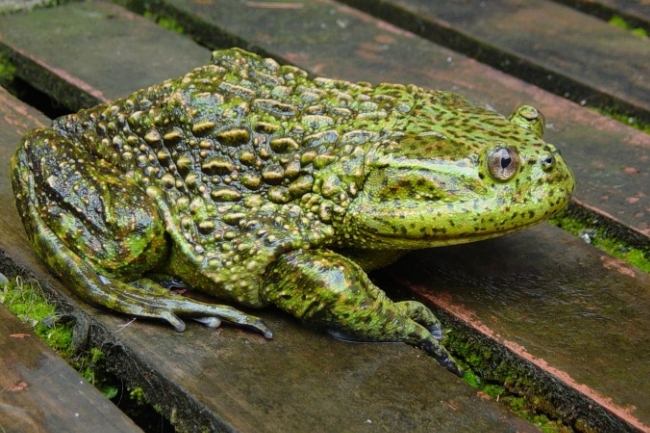
Found in deep waterbodies across central Chile, this green and warty species, is the second largest species in the world, weighing in at 0.5 to 1 kg (1.1 to 2.2 lbs).
Its large size means it is often kept as a pet, as well as being bred for food. Like most frog species, the tadpoles eat mostly vegetation as well as other detritus they find within their aquatic home.
The adult frogs will eat a wide range of animal lifeforms, even birds and fish, including mice if they can overpower one.
African bullfrog
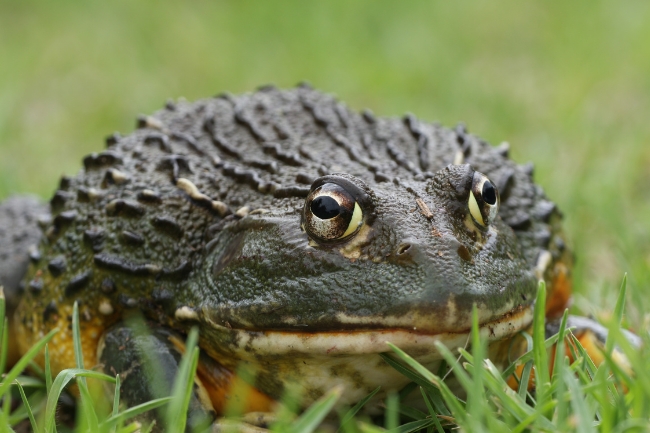
The African bullfrog is unusual in that it can live in dry habitats such as scrublands and savannah. It is found across many African countries, such as Kenya, Botswana and South Africa.
Like all frogs it has maxillary and vomerine teeth, however unusually a bite from this species can be painful to humans, and it often bites in defense.
This fat-looking green species will eat a range of animals from fish to small mammals.
Mountain chicken frog

The mountain chicken frog is native to the Caribbean islands of Dominica and Montserrat, however due to over-exploitation and disease it is now critically endangered.
A nocturnal frog, it inhabits damp forest habitats, and unusually lays its eggs in a burrow rather than underground. An ambush hunter it eats a wide range of species, such as invertebrates, small mammals and birds.
American bullfrog
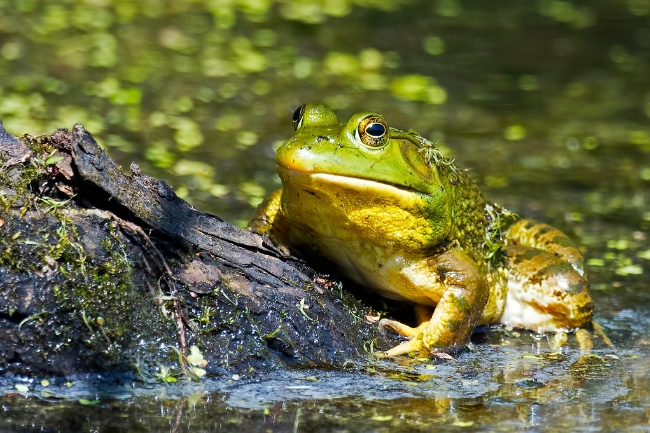
American bullfrogs are a large frog that is native to eastern North America. It has long been spread by humans to many other parts of the globe including parts of South America, Asia and Europe.
Like many other large frogs it is a commonly eaten species. The American bullfrog is a particular effective ambush hunter, and eats a wide range of species, including snakes.
Interesting behavior has been observed when bullfrogs are feeding on live mice, with bullfrogs often opting to submerge themselves in water. This will result in the mouse drowning and becoming easier to eat. This is similar to the behavior of many crocodile species, who drag their prey underwater.
Surinam horned frog
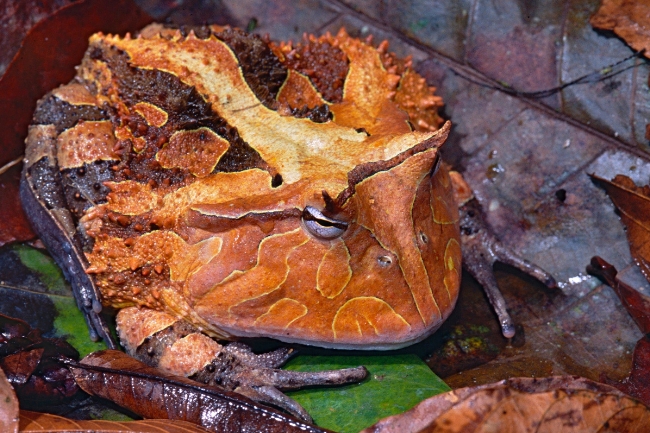
The Surinam horned frog is an amazing looking animal, its large head topped with two horn-like projections, giving it a rather irritated expression. It is known as the Pacman frog due to its resemblance to this famous video game character.
It’s this interesting look, plus its large size, that makes it a popular pet species. Its natural range is in South America, including in the Amazon rainforest, giving it its other name the Amazonian horned frog.
As well as mice these large frogs will eat lizards, fish and even other frogs.
Smoky jungle frog
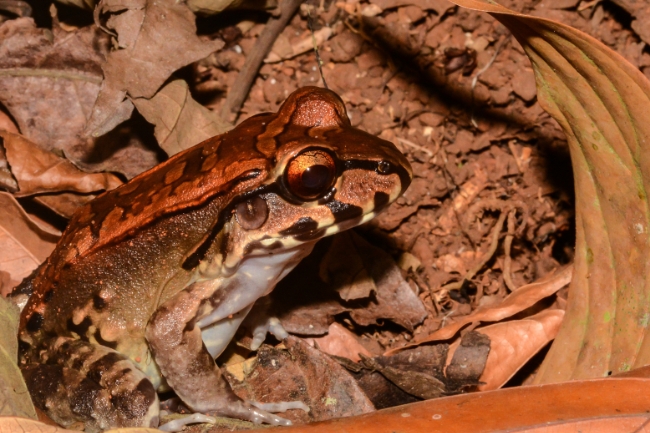
The Smoky jungle frog is found across areas of central and South America, within forested areas and wetlands. This nocturnal frog is usually brown in appearance, with mottled legs.
In order to put off potential predators, the frog exudes poison from its skin, and takes up a defensive posture, by puffing up their bodies to make themselves appear larger than they are.
As well as mice, smoky jungle frogs will eat reptiles such as lizards and snakes, and even feed on bat species.
Cane toads
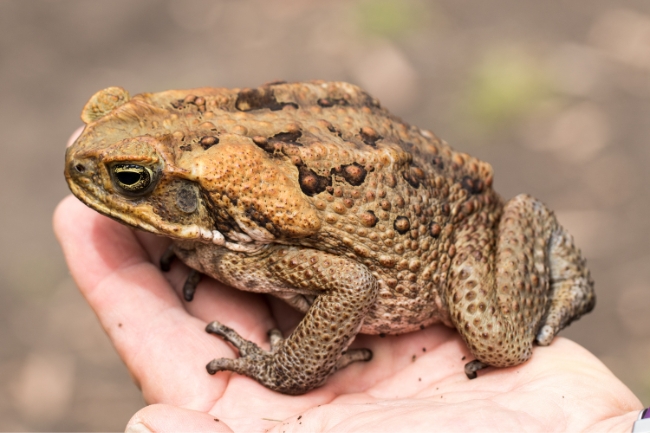
While we tend to separate out frogs and toads, both are part of the same group, with species tending to be labeled toads because they have a warty skin and are larger than other common frogs.
Cane toads are a large brown amphibian that is found in South and central America. It has been introduced to other countries where it isn’t native, such as Australia, where it has become a significant pest species.
Both the adult and the tadpoles are highly toxic if ingested, and can kill animals that attempt to eat them. They are voracious predators, and eat a wide range of animals, from reptiles to invertebrates, to mammals such as bats and mice.
Part of their success is probably their wide diet, as well as their hunting prowess. Unlike many frog species they are able to locate prey by smell.
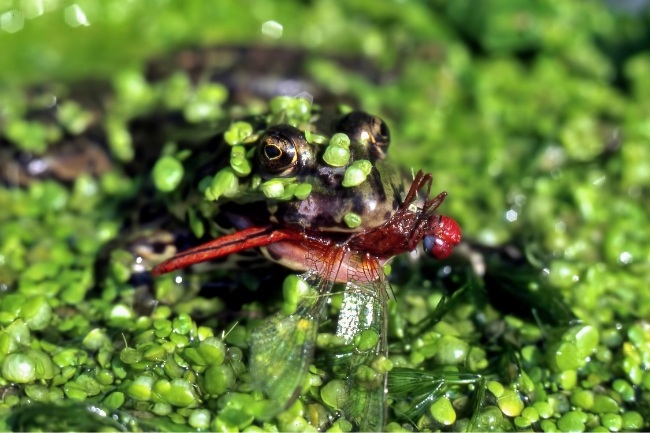
Frog eaters
Frogs are largely opportunistic predators, eating a wide range of animal species, from insects to fish, even to larger prey like birds, reptiles and mammals.
Their main curb to their appetite is what they can fit in their mouth without hurting themselves. There are therefore few species that are happy to eat mice, and those are mostly confined to the larger species.
So while mice might have a few deadly frogs to keep an eye on, most species simply don’t have the stomach for them.

